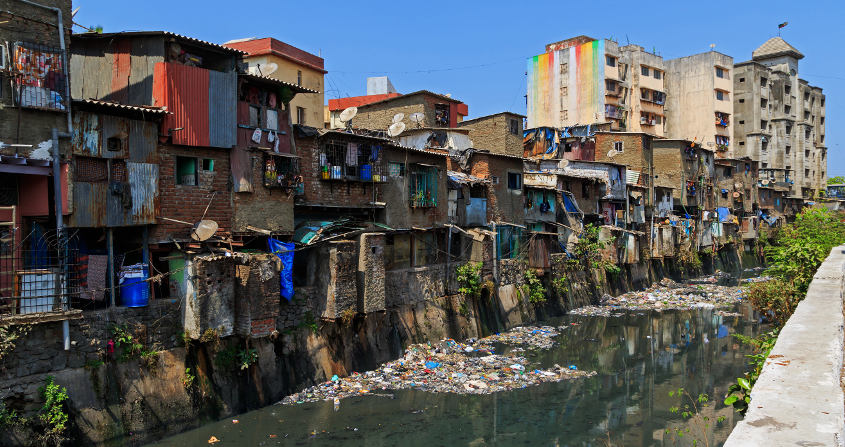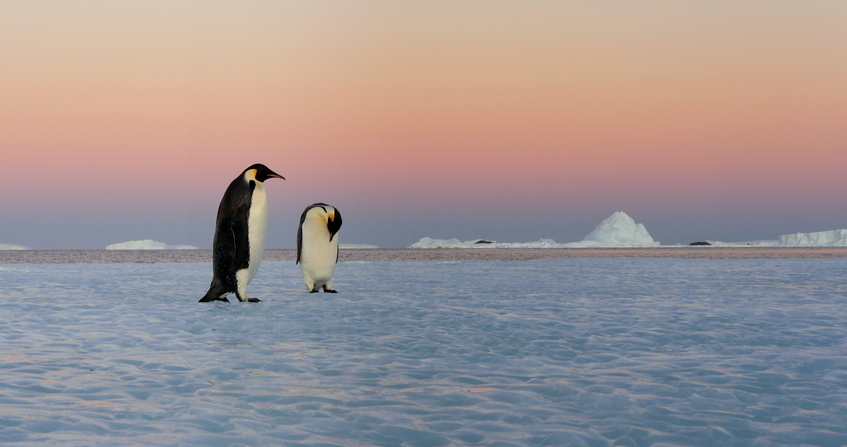Sustainable development
PDF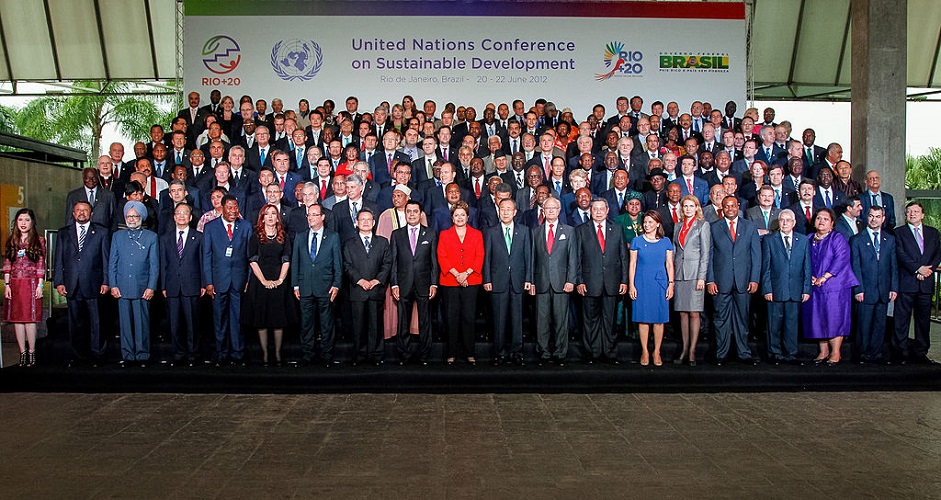
Sustainable development is a concept that has a history of nearly thirty years. Launched at the United Nations level, it has been interpreted in many ways both in different countries and for local companies and initiatives. This article explains its history, main principles and limitations, and concludes with the presentation of several more contemporary formulas associated with it.
Sustainable development can be intuitively understood as a development that is likely to last, or to be “sustainable” if we want to translate more specifically the adjective of English origin sustainable. This objective is fundamentally concerned with the relationship between the environment and societies, and in particular with the environmental vulnerability of societies, towards which it develops principles and strategies. Its scope can cover both the source and resource environment, in industrialized and non-industrialized societies, as well as more specific themes such as climate change and biodiversity or territorial ecology.
Since the late 1980s, when the formula was released, it has been interpreted by multiple stakeholders who have proposed definitions, principles or implementation plans. First conceived in the field of reconciling environment and development at the global level under the strong impetus of the United Nations, the concept has become a basic concept, a framework, that can be compared to others such as democracy or justice.
1. History and dissemination
The Brundtland Report [1] (1987) remained famous for its definition of sustainable development still in use today, which defines it as “development that meets the needs of the future without compromising the ability of future generations to meet their own needs“. This report, commissioned at the request of the United Nations, while emphasizing the possible new factor of unity that would be the common protection of the planet, draws heavily on concepts related to human development: the satisfaction of basic needs, the cooperation of all actors, equity, and even the integration of different components of development. However, older origins of sustainable development can be found in conservation ecology, particularly in reports from IUCN, the International Union for Conservation of Nature.
The Rio Conference (United Nations Conference on Environment and Development, or Earth Summit) in 1992 showed a global interest in sustainable development, articulated in a Declaration of 27 principles, a programme of several hundred pages (Agenda 21), not to mention two major international conventions launched there, one on climate and one on biodiversity (link to climate change and biodiversity).
In the decades that followed, the notion spread around the world in political programmes, non-governmental organizations and companies [2]. Since 1992, sustainable development, interpreted mainly in Europe as the integration of environmental issues into sectoral policies, has led to real progress in terms of local pollution (air, water) and waste management. The objective has also been adopted by states, local authorities or regions as a political principle and has generated a number of institutions and programmes. Thus in France a large ministry has been set up, the Ministry of Ecology, Sustainable Development and Energy. At regional and local level, many institutions and programmes have also been set up (link to territorial ecology).
In practice, sustainable development is associated with different sectors of activity, most often to highlight ecological issues in a broad sense [3]. The term “sustainable” is frequently used as an adjective to describe different activities, or developments such as businesses, cities, nature or landscape management.
For example, the European Conference on Sustainable Cities and Towns was in 2016 at its eighth edition. These exchanges of good practices between cities are supported by ICLEI, the Network of Local Governments for Sustainability.
2. Principles
Fundamentally, sustainable development aims to increase human well-being by taking into account environmental and resource constraints, so as not to risk a decrease in human well-being in the future, particularly because of the environmental vulnerability of societies, but not only. Thus, issues of inequality and justice are very present in this notion. As stated in the first principle of the Rio Declaration: “Human beings are at the centre of sustainable development“. Respect for the environment is therefore instrumental for sustainable development, not a value in itself.
A few years after the Rio conference, sustainable development was increasingly represented by a search for a balance between three spheres: social, economic and environmental. Indicators have also been developed to this end. Thus, in France, the National Sustainable Development Strategy was accompanied by 45 indicators, equally distributed in each of the three spheres [4]. This graph also shows different variations in possible interactions: equitable, liveable, viable. But it should be noted that these representations vary from report to report.
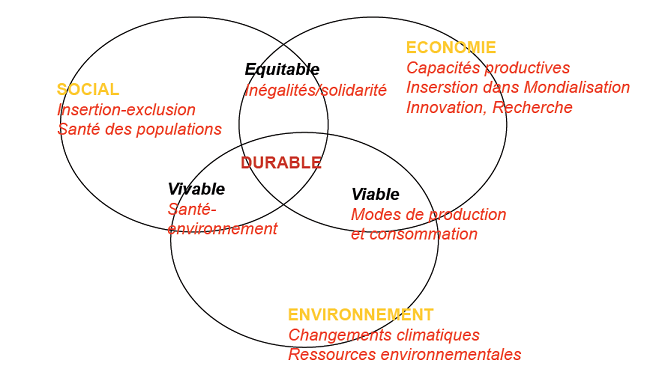
If taken seriously, the objectives of sustainable development lead to proposals for far-reaching reforms of a wide range of institutions and approaches. This is particularly true in the economy [5]. In this context, we can distinguish between low and high sustainability. If we conceive development as a set of growing economic, social and environmental capital, strong sustainability implies that some of the environmental capital must be preserved, these are the so-called “critical” capital. These may include, for example, limits on biodiversity erosion, or the global warming limit of 2°C for the planet compared to pre-industrial temperature. On the other hand, in low sustainability, all capital is substitutable. This means that we can perfectly well allow ourselves to reduce environmental capital if economic or social capital increases by a value that more than compensates for this decrease.
Thus, contrary to the idea that one might have of this question, partial deforestation of tropical forests could be qualified as sustainable, at least in the “weak” version, under certain conditions. The social and economic benefits should outweigh the ecological losses. We can therefore also see from this example that these quantities are very difficult to measure and especially to compare.
The advantage of considering environmental issues in interaction with other human objectives and practices has been decisive in making sustainable development, which is highly consensual, a widely adopted concept. However, its weakness lies in this characteristic itself. Indeed, for the actors who refer to it, the discriminating criteria to be applied to a particular intervention and the search for a particular objective have proved, if we evaluate the experience acquired over several decades, to be too weak [6]. This is particularly the case for major ecosystem changes, such as the erosion of biodiversity, the modification of major pollutant flows, and of course climate change, which both globally and locally question human capacities for adaptation and resilience.
It is a little ironic that human impacts on ecosystems will continue for many future generations, even though this is what the original formula for sustainable development tried to avoid….
3. Companies and sustainable development
It is from the 1990s that we will see more and more companies explicitly claiming sustainable development. The search for a balance between managerial and business perspectives (according to the term used in English-speaking documents) with environmental protection is not new. The principles are those of “ecological modernization”, a school of thought born in the mid-1980s in Northern Europe and partly in the United States [7]. According to ecological modernisation, the solution of certain environmental problems, at least domestic ones, is compatible with the pursuit of the main characteristics of developed societies, through realistic political reforms and process and product renewals, some of which can benefit an economy that is gradually becoming “greener”. Companies thus appear less as part of the problem, as at the beginning of ecologism, than as part of the solution. Sustainable development, by its very terms, promotes the affirmation of a balance between ecological and economic objectives, more than the objective of environmental protection (or nature conservation).
There are many examples. For example, greener construction (insulation, renewable energy sources, greener materials), promoted in France by the Grenelle de l’environnement, which promotes new products, new markets and a number of job creation. In Germany, the renewable energy sector has also been able to create a significant number of jobs.
Companies, as well as major public economic development institutions, will influence the framing of sustainable development to make it evolve even more explicitly towards the search for a balance between the environment, the economy and society. For some companies, the commitment proclaimed for sustainable development will be in line with the corporate social responsibility (CSR) approach. The three proposed poles will therefore differ more and more from the initial terms in which sustainable development was conceived, as we have seen, according to a bipolar vision present generations / future generations, or according to another bipolarity environment / development.
The triangle “environment, economy, social” will continue to prevail until today. But as we have seen, both the three poles and the balance to be found remain relatively unclear, and these compromises in the present do not guarantee the capacities of future generations. In order to allow the conditions for significant progress in the direction advocated by the sustainable development formula, we return to the need for institutional changes on the economic, political level, and probably in the materialization of social aspirations themselves in relation to consumption practices.
4. Associated concepts and heirs
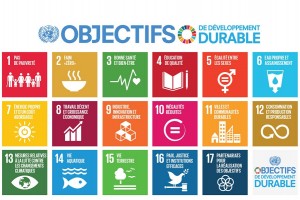
On the other hand, in the face of more particularly environmental objectives, other formulas and concepts have become more powerful. This is the case of the “Green Economy“, a concept created in the wake of ecological modernization. It is an economy whose environmental impacts are decreasing, and where at the same time more ecological aspects of activities are being promoted, such as renewable energies, building insulation, and different environmental management activities. In a more focused way on the efforts to be made in terms of climate prevention, we will also speak of a “low-carbon” economy. Compared to sustainable development, these objectives are probably more concrete, but also more partial, with little consideration of the social aspects of the changes.
Another formula that has had some success in recent years in some European countries is the “Transition” formula. There are various interpretations of this term, whether it is a transition to a low-carbon economy, or initiatives by cities in transition seeking to implement more environmentally friendly local energy and food processes, in particular [9]. With a certain hindsight, we can see here, as in the “Green Economy”, similarities with various programmes previously promoted under the aegis of sustainable development. More controversial, the concept of “Decline” has also had a certain impact in certain spheres of Western societies, including France. Controversial, it does not refer particularly to an economic decline, but to a strong distance from the slogans of economic growth and market consumption and tries to consider the consequences [10].
While there are also analyses in sustainable development that show that development is not growth and that there are necessary ecological and social conditions for growth, the above history shows that this criticism has not been widely heard in concrete sustainable development programmes. Over time, we may wonder whether the unfavourable environmental changes recorded on the planet since the emergence of the concept of sustainable development, nearly thirty years ago, are not the main causes of a weakening of the mobilization behind it. At the same time, the world, which has become multipolar and less readable in its economic and political evolutions, is moving away from the conditions for the emergence of this essentially reformist thought, trying to reconcile the maintenance of certain achievements with a controlled gradual evolution.
References and notes
Cover image. Photo of the Heads of State at Rio 2012. [Source: Flickr: Quarta-feira, 20 de junho)[CC BY-SA 2.0 (http://creativecommons.org/licenses/by-sa/2.0)], via Wikimedia Commons]
[1] WCEDMC (1987), Our Common Future, (Brundtland Report)
[2] Aubertin Catherine and Vivien Franck-Dominique (dir.) (2010), Le développement durable, La Documentation Française.
[3] Veyret Yvette (ed.) (2007), Le développement durable, Editions Sedes.
[4] IFEN (2003), 45 sustainable development indicators. A contribution from IFEN, Etudes et travaux N°41
[5] Godard Olivier (2015), Environment and Sustainable Development. A meta-economic approach, De Boeck.
[6] Zaccai Edwin (2011), 25 years of sustainable development, and after? PUF.
[7] Mol A., Sonnenfeld D., Spaargaren G., ed. (2009), The Ecological Modernisation Reader, Routledge, London
[8] Hopwood Bill, Mellor M. and O’Brian G. (2005), “Sustainable Development. Mapping Different Approaches”, Sustainable Development 13, p. 38-52
[9] Hopkins Rob (2014), They are changing the world: 1001 ecological transition initiatives, Anthropocene, Threshold.
[10] Bayon Denis, Flipo Fabrice, Schneider François (2012) La décroissance. Ten questions to understand and debate, Poche, La Découverte.
The Encyclopedia of the Environment by the Association des Encyclopédies de l'Environnement et de l'Énergie (www.a3e.fr), contractually linked to the University of Grenoble Alpes and Grenoble INP, and sponsored by the French Academy of Sciences.
To cite this article: ZACCAI Edwin (January 5, 2025), Sustainable development, Encyclopedia of the Environment, Accessed January 21, 2025 [online ISSN 2555-0950] url : https://www.encyclopedie-environnement.org/en/society/sustainable-development-2/.
The articles in the Encyclopedia of the Environment are made available under the terms of the Creative Commons BY-NC-SA license, which authorizes reproduction subject to: citing the source, not making commercial use of them, sharing identical initial conditions, reproducing at each reuse or distribution the mention of this Creative Commons BY-NC-SA license.





